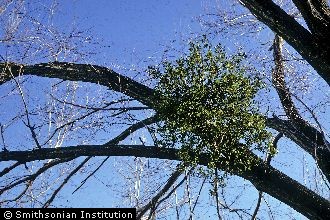 “Oh, the mistletoe hung where you can see… Somebody waits for you, kiss her once for me” sings Burl Ives in the background. Ah, the holidays, cookies and mistletoe. We all know that mistletoe was a good excuse to sneak kisses during the holidays. So, where did that tradition come from and why is mistletoe so revered for its mystical and medicinal qualities?
“Oh, the mistletoe hung where you can see… Somebody waits for you, kiss her once for me” sings Burl Ives in the background. Ah, the holidays, cookies and mistletoe. We all know that mistletoe was a good excuse to sneak kisses during the holidays. So, where did that tradition come from and why is mistletoe so revered for its mystical and medicinal qualities?
There are many myths about kissing under the mistletoe from signs of good will to marriage proposals. According to my research, “This tradition is decidedly pagan in origin and dates back to Scandinavian mythology when Baldur, god of peace was slain by Loki, god of destruction with an arrow made from mistletoe. Outraged by the injustice of Baldur’s death the other gods and goddesses demanded his life be restored. As a token of thanks, Baldur’s mother, Frigga, hung mistletoe and promised to kiss all who passed beneath it, thus establishing the symbolism of love, peace and forgiveness that is now associated with mistletoe.” So, in Scandinavia, mistletoe was considered a plant of peace, under which enemies could declare a truce or quarreling spouses kiss and make-up.
Mistletoe is actually a parasitic plant that grows in mostly in apple trees, and less commonly in oak trees. Since we have tons of oaks here at Shaman’s Grove, we usually can find a nice bunch of mistletoe. Its name is deriv ed from ancient observations that mistletoe would often spontaneously appear on a branch or twig where birds had left droppings. “Mistel” is an Anglo-Saxon word meaning “dung,” and “tan” is the word for “twig”. So, mistletoe literally means “dung-on-a-twig”. (And we want to pucker up with someone under “dung-on-a-twig” :-)?)
ed from ancient observations that mistletoe would often spontaneously appear on a branch or twig where birds had left droppings. “Mistel” is an Anglo-Saxon word meaning “dung,” and “tan” is the word for “twig”. So, mistletoe literally means “dung-on-a-twig”. (And we want to pucker up with someone under “dung-on-a-twig” :-)?)
The Celts, gave us the Christmas connection by using mistletoe as part of the Yule festival where it decorated the houses and strengthened all magical workings, protected the home and caused beautiful dreams during dream time of midwinter. To the Druids, mistletoe was thought to be an “in between”, or a gateway to other worlds and they used it to reach the other world in their shamanic rites. In fact, to my Celtic Ancestors, the mistletoe was so important that they had a specific ritual for gathering it. On the sixth night of the moon after the winter solstice, white-robed Druid priests would cut the oak mistletoe with a golden sickle. Two white bulls would be sacrificed amid prayers that the recipients of the mistletoe would prosper.
The Greeks also thought that it had mystical powers and down through the centuries it became associated with many folklore customs. In the Middle Ages and later, branches of mistletoe were hung from ceilings to ward off evil spirits. In Europe they were placed over house and stable doors to prevent the entrance of witches. And, and a sprig hung over a child’s cradle prevents theft from fairies. It was also believed that the oak mistletoe could extinguish fire. This was associated with an earlier belief that the mistletoe itself could come to the tree during a flash of lightning. To repel evil spirits burn mistletoe, and by placing mistletoe under or on your bed it will ensure a good night’s sleep and enhance dreams.
Christian folklore believes mistletoe was once a tree, of whose wood the cross on which Christ died was made. The tree then shriveled up with shame, changing into a plant that pours down good fortune on all who pass under it.
Maybe warding off “evil spirits” includes disease as well, for mistletoe leaves and twigs have been used to cure numerous ailments, such as hysteria, convulsions of delirium, for stopping internal hemorrhages, neuralgia, epileptic seizures, urinary disorders, heart disease, diabetes and lowers cholesterol and blood pressure. No wonder this parasite was often called All Heal by the Ancients. But do note that the berries of mistletoe are poisonous. So, before you go making any tea, check with your herbalist on proper use of the herb.
Since it’s Mistletoe Season, hang a spring or two to keep away those evil spirits (Don’t think it works on in-laws L :-)) and grab a holiday kiss or two.
Until next time-
Mitakuye Oyasin (A Lakota prayer reminding us we are all related),
Debbie
